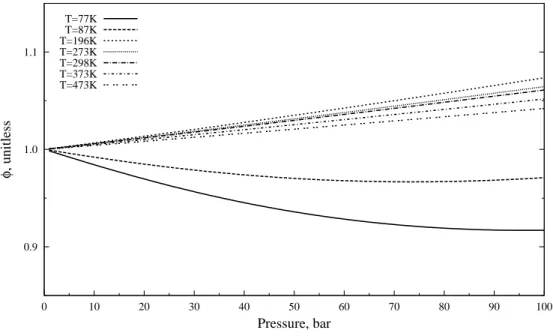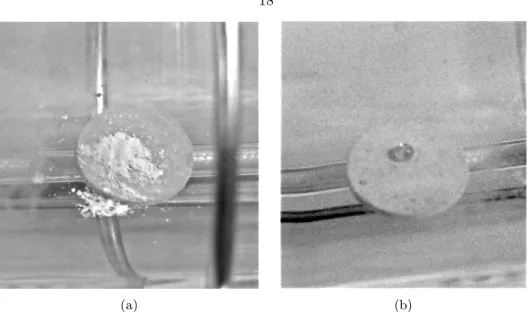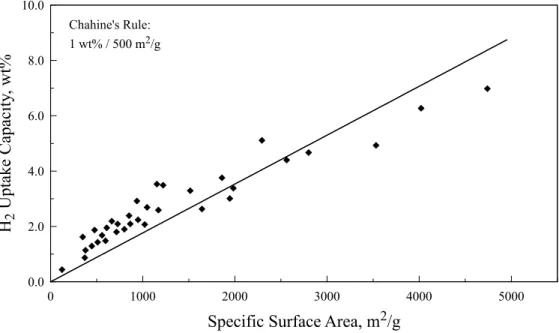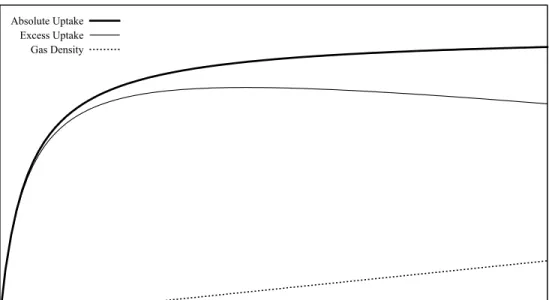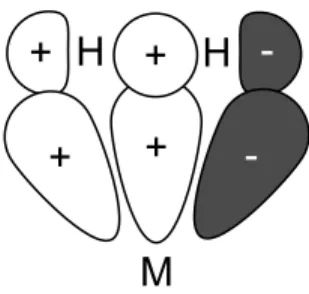Hydrogen storage technologies that promote the compression of the gas into usable volumes are a critical component for the further development of a hydrogen fuel-based economy. Results from calculations for substitution of the metal center reproduced qualitative bond strength trends of 5d > 3d > 4d previously reported for group 6 metals.
Background
These values correlate directly with the thermodynamic properties of the reaction between the solid storage medium and the hydrogen atmosphere, and the evaluation of the standard enthalpy. H◦, and standard entropy, ∆S◦, of hydrogen absorption is the primary goal of research into hydrogen storage materials.
Evaluation of Thermodynamic Properties
Pressure and temperature measurements are obtained on the reactor and on each of the available volumes. Analysis of the data to obtain thermodynamic information depends on the expected interaction mechanism.
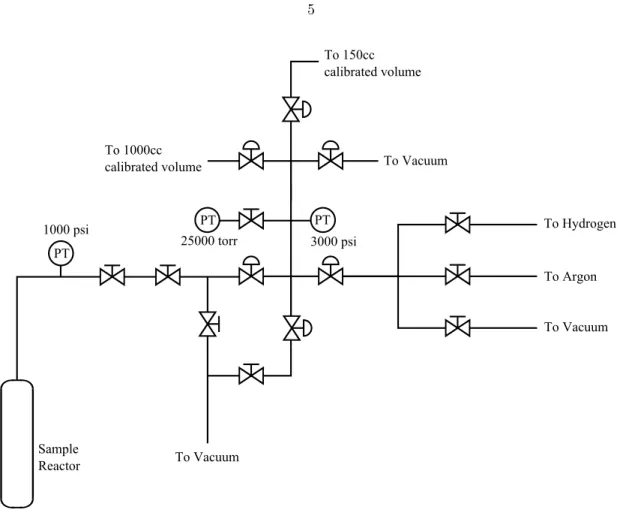
Properties of Absorption Materials
Absorption Thermodynamics
Given the equivalent thermodynamic system of the Sieverts reactor, shown schematically in Figure 1.2, the equilibrium state is between the gas. This definition of equilibrium for absorption systems is universal and independent of the absorption mechanism.
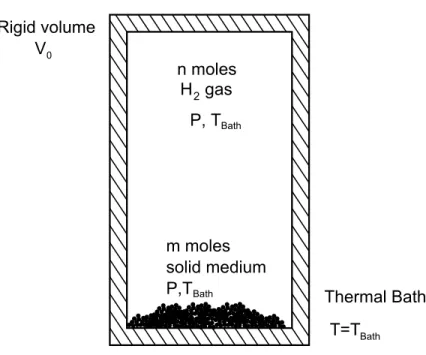
State-of-the-Art: Absorption Materials
This ammonia release is seriously detrimental to the performance of the material in fuel systems;. A balance between the advantages of the thermodynamic destabilization and the kinetic stabilization must therefore be found for the efficient use of destabilized mixtures.
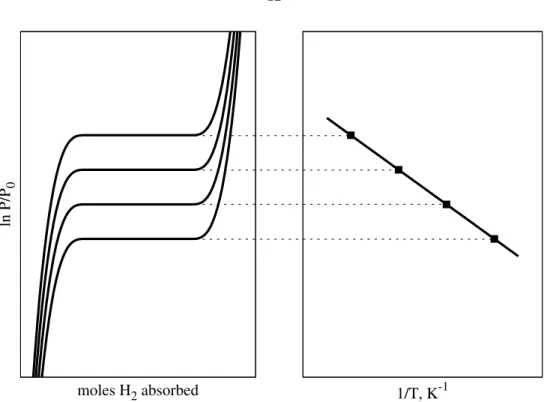
Properties of Physisorption Materials
Physisorption Thermodynamics
However, it is difficult to work with, and the specific volume of hydrogen on the surface of the substrate is difficult to determine. Absolute isotherms are only available from theoretical calculations, which require a definition of the Gibbs partition surface.
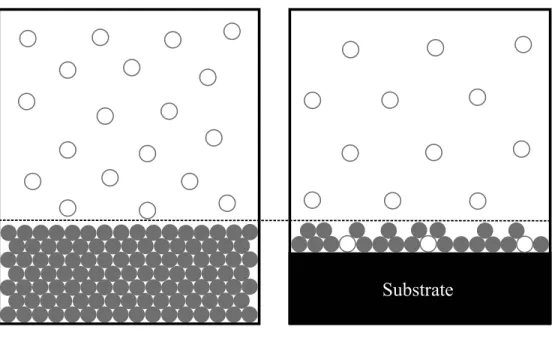
State-of-the-Art: Physisorption materials
Research efforts in this field related to hydrogen storage are increasingly focused on engineering applications and reducing the costs associated with the production of these materials. In addition to work with basic materials, research into improvements in scale-up and large-scale production of MOFs is needed before these materials can be implemented outside the laboratory.
Kubas Binding
Back donation from the metal center to the π∗ orbital of the olefin, which becomes a bonding orbital with respect to the complex, prevents complete breakage of the π bond and stabilizes the complex. A strong σ donor transitioning to the dihydrogen complex, such as hydride, also reduces H-H bond elongation and increases dihydrogen character by forcing electron density to remain within the σ orbital of the hydrogen molecule, despite increased electron density at the metal center.
![Figure 2.1: Ball-and-stick model 91 of the organometallic dihydrogen fragment [FeH(η 2 -H 2 )dppe 2 ] + , showing octahedral configuration of the central iron atom and side-on coordination of the hydrogen molecule to the metal center](https://thumb-ap.123doks.com/thumbv2/123dok/10413075.0/43.918.279.682.91.519/organometallic-dihydrogen-fragment-octahedral-configuration-coordination-hydrogen-molecule.webp)
Synthesis and Characterization
Synthetic Routes
This method provides effective protection of the binding site during synthesis, and the small, gaseous N2 molecule can be removed from the coordination site in the solid state more easily than agostic interactions arising from bulky ligands. Displacement of a charged ligand is generally not desirable for hydrogen storage applications due to the weight of the persistent anion; however, methods exist to reduce the complex in situ to separate the ion pair.
Dihydride/Dihydrogen Identification
Direct acidification of a hydride by the strong acid of a weakly coordinating anion in an organic solvent, producing a dihydrogen salt that is poorly soluble in the organic solvent, enables clean production and purification of the complexes and is used for almost all dihydrogen complex production because of the simplicity of the synthetic method. JHD, the coupling constant for the spin-spin coupling of the hydrogen and deuterium atoms is measured as shown and is proportional to the H-D bond distance, and is absent in the absence of a bond.
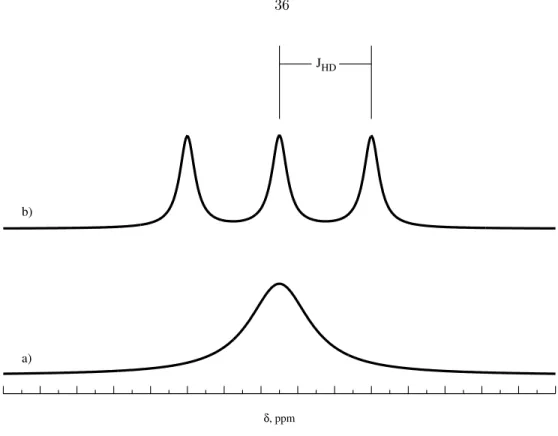
Binding Strength and Hydrogenation Thermodynamics
While interatomic distances can provide relative measures of dihydrogen bond strength in similar families of complexes, these values provide only approximations to bond strength and are not universally applicable as measures of thermodynamic properties. In addn., we report electronic structure calculations on the hydrogenation of [M(CO)dppe2]+ (M = Mn, Tc, Re) fragments to examine trends in binding energy within group 7 metals.
Experimental
H 2 Absorption Measurements
Higher pressures during kinetic measurements were recorded using an MKS model 870B33PCD2GC1 capacitance transducer with a 0-3000 psi range. After completion of the measurement, the reactor and manifold were evacuated to 10-7 torr before heating to the next temperature.
Computations
Vibration analysis in the rigid rotor approach was performed to obtain distribution functions and normal modes of the fragments, qtot, at a pressure of 1 atm. The corrected energy, E, for each fragment was obtained as the sum of the ground state energy, 0, and the thermal correction of the energy obtained from vibrational analysis, corr(T), which includes contributions from translational, vibrational, and rotational energy. movements of the molecule.
![Figure 3.1: Relaxed structure of the [Mn(η 2 -H 2 )(CO)dppe 2 ] + cation, showing the hydrogen molecule aligned along the P-Mn-P axis](https://thumb-ap.123doks.com/thumbv2/123dok/10413075.0/59.918.234.723.136.574/figure-relaxed-structure-cation-showing-hydrogen-molecule-aligned.webp)
Results and Discussion
Experimental Results
With this interpretation of the coordination site, we investigated the binding behavior by fitting the experimental isotherms to the Langmuir model. The values of Keq derived from the fitted values of α and the R2 values of the fits are shown in 3.1.
![Figure 3.2: Absorption isotherms for hydrogen gas onto [Mn(CO)dppe 2 ][BArF 24 ]. Solid lines are Langmuir isotherm fits to the data.](https://thumb-ap.123doks.com/thumbv2/123dok/10413075.0/61.918.173.752.124.533/figure-absorption-isotherms-hydrogen-barf-solid-langmuir-isotherm.webp)
Computational Results
This correction removes half of the mode contribution from the total partition function, taking into account the reduction in the number of states due to symmetric rotation. The experimental result of 0.344 for the fraction of active manganese centers apparently represents the fraction of the total manganese centers in the open configuration. Once precipitated, the thermal stability of the active site fraction suggests that solid-state kinetic stabilization prevents exchange between the two configurations.
This stabilization will prevent hydrogen absorption over agostic complexes in the solid state, even if favorable thermodynamics are predicted, due to the inability of the ligand to leave the binding site. Values for the rotational entropy of the bound state at 298K and 373K for each of the complexes appear in 3.2.
![Figure 3.5: Comparison of simulated isotherms for H 2 absorption onto [Mn(CO)dppe 2 ] + (solid black lines) to experimental data for [Mn(CO)dppe 2 ][BArF 24 ].](https://thumb-ap.123doks.com/thumbv2/123dok/10413075.0/67.918.170.752.127.535/figure-comparison-simulated-isotherms-absorption-solid-black-experimental.webp)
Conclusions
- X-Ray Diffraction
- M¨ ossbauer Spectroscopy
- Computation
- Kinetic Isotherms
However, since both hydrogen atoms remain attached to the same metal center, the assumptions of the Langmuir isotherm are not violated. No characterization studies are available for [OsHdppe2]+ or [RuHdppe2]+ complexes, despite the stability of the ruthenium species. Evidence for the identification of the thermal decomposition product [FeH(η2-H2)dppe2][NTf2] (NTf2 = bis(trifluoromethylsulfonyl)imide) by Mossbauer spectroscopy and other techniques is presented below, and simulated thermodynamic parameters for hydrogen bond interaction in the group fragments are given 8 [MH(η2-H2)dppe2]+ (M = Fe, Ru, Os).
Distribution functions of the fragments,qtot at a pressure of 1 atm were also obtained from vibration analysis. Kinetic isotherms were recorded for the thermal release of the H2 ligand from [FeH(η2-H2)dppe2][NTf2] using a custom Sieverts apparatus.
Results and Discussion
Experimental Results
Residual gas mass spectroscopy was performed during the evacuation of the reactor to identify the decomposition products. Thermal decomposition by direct heating of the [FeH(η2-H2)dppe2][NTf2] crystals under vacuum was attempted by the methods described in the procedures. Because of this extraordinary reactivity, x-ray diffraction patterns could not be obtained and the structure of the decomposition product could not be determined.
EQS values describe perturbations of the electric field around the metal center due to variations in the chemical environment resulting from the attached ligands, specifically asymmetric perturbations, and are less sensitive to changes in the cation-anion pairing. The agreement of the EQS values with the literature values therefore provides strong evidence for the presence of the [FeHdppe2]+ cation in the decomposed sample.
![Figure 4.1: Kinetic measurements for hydrogen release from the reversible thermal decomposition of [FeH(η 2 -H 2 )dppe 2 ][NTf 2 ]](https://thumb-ap.123doks.com/thumbv2/123dok/10413075.0/79.918.181.760.129.530/figure-kinetic-measurements-hydrogen-release-reversible-thermal-decomposition.webp)
Computational Results
- M¨ ossbauer Simulations
- Isotherm Simulations
The geometries of the singlet and triplet five-coordinate states were similar to those found by Franke et al. Bautista et al.96 found by NMR experiments that dihydrogen and hydride ligands can rapidly exchange positions at room temperature in iron-osmium complexes with the formation of the transient trihydride [MH3dppe2]+. N−n↑−n↓)!e−β∆E(n↓+n↑)eβµgas(n↓+n↑) (4.5) where the arrows below the index indicate the orientation of the binding molecule with the total number of bound dihydrogen molecules n=n↓ +n↑.
The broad peak at 400 cm−1 in the neutron scattering experiment thus probably corresponds to the primary mode of rotation of the dihydrogen molecule. The standard enthalpy and entropy obtained from the Keq values of the simulated Langmuir isotherms appear in Table 4.2.

Conclusions
A modification of the Langmuir isotherm model used to describe the behavior of group 7 dihydrogen complexes was applied to hydrogen absorption on singlet-state complexes [MHdppe2]+ (M = Fe, Ru, Os). This model accurately described the reported behavior for the ruthenium and osmium complexes and illustrated the magnitude of the spin-state transition to absorption behavior in the iron complex, which showed singlet-state enthalpy values similar to the manganese complex reported in the previous chapter despite experimental evidence for a much stronger bond. However, the magnitude of the differences between the metal centers was significantly different, especially in the osmium complexes.
ECP theory calculations of the total molecular energy have been shown to be effective tools for producing very accurate estimates of the adsorption equilibrium behavior for dihydrogen complexes. The rotational mode of the dihydrogen molecule in the complex was the only mode found to be significantly populated in the dihydrogen complexes that would be absent in the corresponding hydride complexes and accounted for up to ∼11 J/mol-K of the entropy change.
Considerations for Future Studies
Known Dihydrogen Complexes for Hydrogen Storage
Development of higher weight dihydrogen complexes for hydrogen storage is therefore a viable method to provide additional control of operating properties. However, dihydrogen complexes containing significant percentages of removable hydrogen are rare.88 Most complexes contain less than 1 wt. % hydrogen; the complex CpMn(H2)(CO)2, a half-sandwich complex, has the highest reportable weight percent dihydrogen for isolable dihydrogen complexes at 1.1 wt%. Reports of dihydrogen complexes as potential hydrogen storage materials are further complicated by poor communication of fuel system requirements.
Substantial material discovery efforts will be needed if the dihydrogen complexes are to meet the USDOE's gravimetric capacity requirements. Stationary applications, such as fuel storage systems at refueling stations or power generation plants, may have more relaxed gravimetric capacity requirements and may use currently known dihydrogen complexes.
Computational Discovery of New Complexes
Others, such as [Ru(H2O)5(H2)]+ and [Os(NH3)5(H2)]+, exist only as solvated ions, requiring a large fraction of the weight of the storage material to be solvent. The computational techniques presented in this paper provide not only methods to evaluate equilibrium behavior in known complexes, but also an opportunity to discover and screen new materials for hydrogen storage applications. Light complexes that have not otherwise been found to absorb hydrogen at room temperature but are otherwise of interest due to their hydride character, such as Ni(dmpe)2, can be evaluated for direct hydrogenation and use as hydrogen storage options.
Trends have been developed for the relationship between the identity of the trans ligand and the H-H bond distance;168 additional studies using the Langmuir isotherm can now be included to evaluate the full reaction coordinate. Complexes of the M(dmpe)2 structure are known for 3d transition metals from Cr to Ni,164–167 and appropriate calculations can provide trends across the periodic table.
Engineering Considerations
Sieverts Apparatus Schematic
General Thermodynamic System for Sieverts Measurements
Fugacity Coefficient of Hydrogen at Relevant Temperatures and Pressures
Idealized Pressure-Composition Isotherm and van’t Hoff Plot for Absorption Processes 12
Chahine’s Rule for Physisorption Materials
Gibbs’ Dividing Surface in Liquid-Vapor and Gas-Adsorbate Systems
Absolute vs. Excess Adsorption Isotherms
Octahedral Coordination and Side-On Bonding in [FeH(η 2 -H 2 )dppe 2 ] +
Bonding Model for Orbitals During Transition Metal-Dihydrogen Binding
Coupling Constant J HD in Substituted Dihydrogen Complexes
Structure of the [Mn(η 2 -H 2 )(CO)dppe 2 ] + Cation
Absorption Isotherms for H 2 onto [Mn(CO)dppe 2 ][BArF 24 ]
Initial Rate Kinetics for H 2 Absorption onto [Mn(CO)dppe 2 ][BArF 24 ]
Van’t Hoff Plot for H 2 Absorption onto [Mn(CO)dppe 2 ] +
Simulated Isotherms for H 2 Absorption onto [Mn(CO)dppe 2 ] +
Thermal Decomposition Kinetics of [FeH(η 2 -H 2 )dppe 2 ][NTf 2 ]
X-Ray Diffraction Structure of [FeH(η 2 -H 2 )dppe 2 ][NTf 2 ]
M¨ ossbauer Spectra of [FeH(η 2 -H 2 )dppe 2 ][NTf 2 ] and [FeHdppe 2 ][NTf 2 ]
